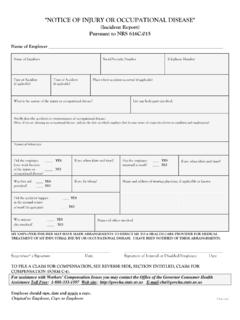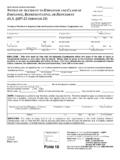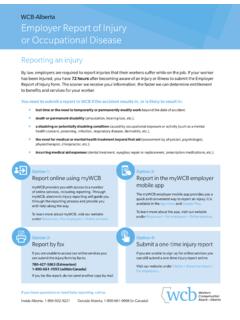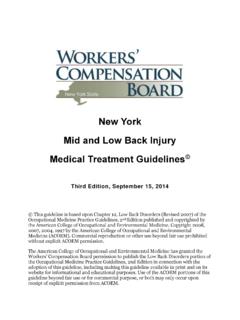Transcription of Occupational injuries - International Labour Organization
1 Occupational injuries Introduction The o ccupational safety and health at work are vital components of decent work. Statistics on Occupational injuries are essential to assess the extent to which workers are protected from work-related hazards and risks. In this regard, indicators on Occupational injuries are complementary to those on Labour inspection, also included in ILOSTAT. Given its usefulness in conveying valuable information on the conditions of workers, it was included as one of the indicators proposed to measure progress towards the achievement of the Sustainable Development Goals (SDG), under Goal 8 (Promote sustained, inclusive and sustainable economic growth, full and productive employment and decent work for all).
2 1 ILOSTAT presents statistics on both fatal Occupational injuries and non-fatal Occupational injuries . In order to fathom more easily the work-related risks workers are exposed to, it is preferable not to look at the gross number of Occupational injuries , but to present them as a ratio. This is why ILOSTAT features prominently statistics on the number of cases of fatal and non-fatal Occupational injuries per 100 000 workers, disaggregated by sex and migrant status and also by economic activity, compiled from national sources. For users interested in more detailed statistics, ILOSTAT also contains statistics on days lost due to Occupational injuries by sex and migrant status and by economic activity.
3 Concepts and definitions An Occupational injury is defined as any personal injury , disease or death resulting from an Occupational accident; an Occupational injury is therefore distinct from an Occupational disease , which is a disease contracted as a result of an exposure over a period of time to risk factors arising from work activity. An Occupational accident is an unexpected and unplanned occurrence, including acts of violence, arising out of or in connection with work which results in one or more workers incurring a personal injury , disease or death. A case of Occupational injury is the case of one worker incurring an Occupational injury as a result of one Occupational accident.
4 An Occupational injury could be fatal (as a result of Occupational accidents and where death occurred within one year of the day of the accident) or non-fatal with lost work time. Incapacity for work is the inability of the victim, due to an Occupational injury , to perform the normal duties of work in the job or post occupied at the time of the Occupational accident. Incapacity can be permanent or temporary. Cases of permanent incapacity for work are cases of Occupational injury where the persons injured were never able to perform again the normal duties of work in the job or post occupied at the time of the Occupational accident causing the injury .
5 Cases of temporary incapacity are cases of Occupational injury where the workers injured were unable to work from the day after the day of the accident, but were later able to perform again the normal duties of work in the job or post occupied at the time of the Occupational accident causing the injury within a period of one year from the day of the accident. 1 Proposed SDG indicator refers to the frequency rates of fatal and non-fatal Occupational injuries , by sex and migrant status. For the official list of proposed SDG indicators, see: The workers in the particular group under consideration and covered by the source of the statistics of Occupational injuries are known as the workers in the reference group.
6 In the case of a notification system, it is the number of workers in, for example, the establishments or selected economic activities covered by the system as set out in the relevant legislation or regulations. Days lost due to temporary incapacity refers to the total number of calendar days during which those persons temporarily incapacitated were unable to work, excluding the day of the accident, up to a maximum of one year. Temporary absences from work of less than one day for medical treatment are not Method of computation Given that relative measures are easier to interpret and favour comparability between countries, activities and over time, ILOSTAT presents statistics on the Occupational injuries incidence rate, calculated as follows.
7 Fatal Occupational injuries incidence rate = Number of new cases of fatal Occupational injuries during the reference period x 100 000 Number of workers in the reference group Non-fatal Occupational injuries incidence rate = Number of new cases of non-fatal Occupational injuries during the reference period x 100 000 Number of workers in the reference group Recommended sources Statistics on Occupational injuries could come from a variety of sources, including various types of administrative records (insurance records, Labour inspection records, records kept by the Labour ministry or the relevant social security institution, etc.)
8 , establishment surveys and household surveys. The recommended data sources for Occupational injuries statistics are national systems for the notification of Occupational injuries (such as, Labour inspection records and annual reports; insurance and compensation records, death registers), supplemented by household surveys (especially in order to cover informal sector enterprises and the self-employed) and/or establishment surveys. It is worth noting that fatal and non-fatal Occupational injuries tend to be notified to and compensated by different agencies, so when using statistics from administrative records, statistics on fatal and non-fatal Occupational injuries would very likely come from different records.
9 This means that the sources may have different coverages, and thus, fatal and non-fatal Occupational injuries , even though very complementary, would not be strictly comparable. 2 For more detailed information, please refer to the Resolution concerning statistics of Occupational injuries (resulting from Occupational accidents), adopted by the 16th International Conference of Labour Statisticians (October 1998); Interpretation and use of the indicator Data on Occupational injuries are essential for planning preventive measures. The role of the indicators described in this document is to identify important areas to which attention should be paid.
10 In order to be able to design more targeted prevention mechanisms and related policies it is recommended to disaggregate and analyse this indicator by sex, occupation, economic activity, or any combination of these. For instance, workers in occupations and activities of highest risk can be targeted more effectively for inspection visits, development of regulations and procedures, and also for safety campaigns. There may be problems of under reporting of fatal Occupational injuries , and proper systems should be put in place to ensure the best reporting and data quality. Under reporting is thought to be present in countries at all levels of development, but may be particularly problematic in some developing countries.

















